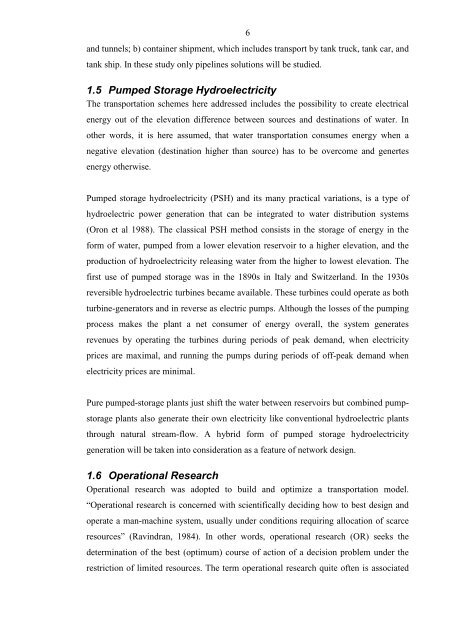Ben-Gurion University of the Negev Jacob Blaustein Institutes for ...
Ben-Gurion University of the Negev Jacob Blaustein Institutes for ...
Ben-Gurion University of the Negev Jacob Blaustein Institutes for ...
You also want an ePaper? Increase the reach of your titles
YUMPU automatically turns print PDFs into web optimized ePapers that Google loves.
6<br />
and tunnels; b) container shipment, which includes transport by tank truck, tank car, and<br />
tank ship. In <strong>the</strong>se study only pipelines solutions will be studied.<br />
1.5 Pumped Storage Hydroelectricity<br />
The transportation schemes here addressed includes <strong>the</strong> possibility to create electrical<br />
energy out <strong>of</strong> <strong>the</strong> elevation difference between sources and destinations <strong>of</strong> water. In<br />
o<strong>the</strong>r words, it is here assumed, that water transportation consumes energy when a<br />
negative elevation (destination higher than source) has to be overcome and genertes<br />
energy o<strong>the</strong>rwise.<br />
Pumped storage hydroelectricity (PSH) and its many practical variations, is a type <strong>of</strong><br />
hydroelectric power generation that can be integrated to water distribution systems<br />
(Oron et al 1988). The classical PSH method consists in <strong>the</strong> storage <strong>of</strong> energy in <strong>the</strong><br />
<strong>for</strong>m <strong>of</strong> water, pumped from a lower elevation reservoir to a higher elevation, and <strong>the</strong><br />
production <strong>of</strong> hydroelectricity releasing water from <strong>the</strong> higher to lowest elevation. The<br />
first use <strong>of</strong> pumped storage was in <strong>the</strong> 1890s in Italy and Switzerland. In <strong>the</strong> 1930s<br />
reversible hydroelectric turbines became available. These turbines could operate as both<br />
turbine-generators and in reverse as electric pumps. Although <strong>the</strong> losses <strong>of</strong> <strong>the</strong> pumping<br />
process makes <strong>the</strong> plant a net consumer <strong>of</strong> energy overall, <strong>the</strong> system generates<br />
revenues by operating <strong>the</strong> turbines during periods <strong>of</strong> peak demand, when electricity<br />
prices are maximal, and running <strong>the</strong> pumps during periods <strong>of</strong> <strong>of</strong>f-peak demand when<br />
electricity prices are minimal.<br />
Pure pumped-storage plants just shift <strong>the</strong> water between reservoirs but combined pump-<br />
storage plants also generate <strong>the</strong>ir own electricity like conventional hydroelectric plants<br />
through natural stream-flow. A hybrid <strong>for</strong>m <strong>of</strong> pumped storage hydroelectricity<br />
generation will be taken into consideration as a feature <strong>of</strong> network design.<br />
1.6 Operational Research<br />
Operational research was adopted to build and optimize a transportation model.<br />
“Operational research is concerned with scientifically deciding how to best design and<br />
operate a man-machine system, usually under conditions requiring allocation <strong>of</strong> scarce<br />
resources” (Ravindran, 1984). In o<strong>the</strong>r words, operational research (OR) seeks <strong>the</strong><br />
determination <strong>of</strong> <strong>the</strong> best (optimum) course <strong>of</strong> action <strong>of</strong> a decision problem under <strong>the</strong><br />
restriction <strong>of</strong> limited resources. The term operational research quite <strong>of</strong>ten is associated
















